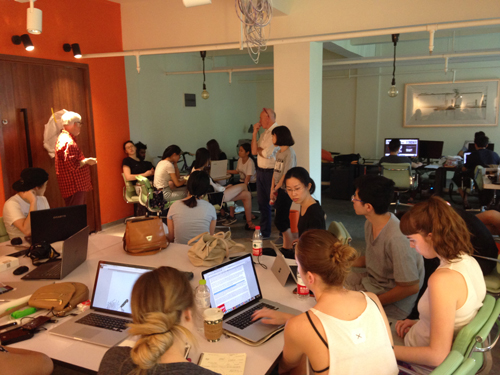News
Australian design students from the University of New South Wales (UNSW) visited Chongqing in China in September 2016 to participate in the Beijing Design Week (BJDW).
The trip was part of a three-week undergraduate education program titled MAD.LAB which is offered to the University's art, design, digital media, architecture and computational design students. Developed in partnership with the Sichuan Fine Arts Institute (Chongqing), the aim of the visit was to promote, strengthen and consolidate connections between young Australian and Chinese creatives.
The original seeds for MAD.LAB were sown during a chance meeting at Beijing Design Week in 2012 between Dr Ian McArthur, a senior academic at UNSW Art & Design, and Sam Priestman, a British entrepreneur based in Chongqing.
Discussions throughout 2013 and 2014 developed an outline for an intensive interdisciplinary program in Chongqing, a sprawling metropolis of almost ten million people at the confluence the Yangtze and Jialing Rivers in south-western China.
The first project emerging from this partnership was staged in Chongqing in March 2015. For visiting Australian design students, Chongqing presents a stark contrast to the more common destinations for study travel offered in the UK, Europe and USA.
MAD.LAB uses the practice of mapping as a research methodology to think about and visualise new approaches to place-making and the creation of stories about the urban environment, with a view to translating them into cohesive and compelling design tactics.
The Chongqing environment is an extraordinary rich site for exploring and testing concepts about the city and urban interaction. Recent years have seen a pause in China's continuous real estate rollout in favour of more sustainable development. The previous 'catch-up' phase of China's growth – which concentrated on greenfield development and mass construction – is now guided by policies that support consumer economies, entrepreneurialism, start-ups, service industries, brownfield regeneration and the re-purposing of buildings.
The Chinese government has emphasised the importance of the creative industries, clusters, and 'makerspaces' as a way to stimulate innovation and successful urban development. Not only in the eastern cities of Shanghai, Beijing and Guangzhou but also in centres such as Chongqing.
MAD.LAB's education program introduces students to this set of flows and relationships, functioning as a seeding initiative within Chongqing's metropolis that seeks to serve as an exemplar for thinking about contemporary urban life – one that thinks ahead to the needs and dreams of its citizens – young and old.
The talent and skills of these future designers and their work in Chongqing were showcased via a pop-up exhibition that was part of the Australian Embassy in Beijing program, Australia @ BJDW.
Invited experts and creatives exchanged critical, transcultural and interdisciplinary ideas about our shared urban future, through a workshop and forum that were based on the exhibition.
'(MAD.LAB) promotes Australian design education as international, collaborative, contemporary, diverse, and a source of excellence by showcasing sustainability, co-design, adaptive reuse, place-making, media facades and metadesign as a way of creating a shared vision for tackling 'wicked problems' in fair and equitable ways,' says Dr Ian McArthur.
In addition to providing a learning context that supports Australian students to engage with their Chinese peers, communities and industry in Chongqing, other benefits include the emerging strengthening and consolidation of relationships with all the project partners and stakeholders including the Australian Consulate in Chengdu.
'This enables the program to respond to useful feedback from external sources and facilitate new conversations about design and cities and Australia's role in making a useful contribution,' says Ian.
MAD.LAB is supported by the Australian Cultural Diplomacy Grants Program (ACDGP). The ACDGP supports the delivery of high quality public diplomacy initiatives which promote our economic, artistic and cultural assets to an international audience to strengthen Australia's reputation as an innovative, creative nation and foster collaborative people-to-people links internationally.


